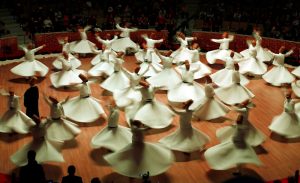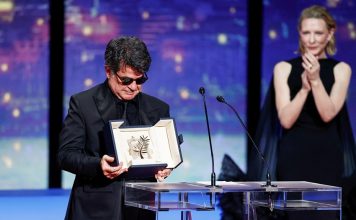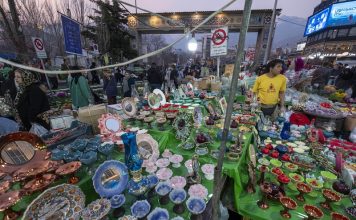By Nazanine Nouri
UNESCO is this week holding a conference, exhibition and two concerts at its headquarters in Paris to commemorate the 815th anniversary of the birth of Mawlana, the 13th-century Persian poet, scholar and Sufi mystic better known in the West as Rumi.
The event, “815 Years with Mawlana” – organized from June 5-8 by the United Nations Educational, Scientific and Cultural Organization (UNESCO) – will commemorate Mawlana Jalal al-Din Balkhi (known to Iranians as Jalal al-Din Muhammad Balkhi).
The program includes an exhibition around Mawlana’s works; a full-day conference on June 7 entitled “Mawlana’s works and his contribution to the development of world culture;” and two concerts: “Eternal Melodies, 8 Centuries of Rumi-Mawlana” on June 7 and 8 at 8 p.m.
The “815 Years with Mawlana” celebration is organized on the initiative of the Government of the Republic of Tajikistan in cooperation with UNESCO and the Rudaki Association in Paris.
Already in 2007, a commemorative medal was issued by UNESCO on the 800th anniversary of the birth of Mawlana Balkhi-Rumi “to honor one of the great humanists, philosophers, and poets who belong to humanity in its entirety.”
UNESCO Declares Iran’s Hyrcanian Mixed Forests World Heritage Site
In its explanatory note at the time, UNESCO wrote:
“In their passion, honesty, and gorgeous imagery, the writings of Mawlana have become a means of connecting directly with the Divine. His works, thoughts and teachings bear supreme witness, in a manner transcending all national, cultural and civilizational boundaries, to the sweet mysteries of divine truth.”
“The world of Mawlana is not exclusive but is rather the highest state of a human being – namely, a fully evolved human,” added UNESCO. “He offends no one and includes everyone, as a perfect human being who is in search of love, truth and the unity of the human soul.”

Jalal al-Din Muhammad Balkhi — known in the West as Rumi — was the greatest Sufi mystic and poet of the Persian language, famous for his lyrics and his didactic epic Masnavi-ye Ma’navi [‘Spiritual Couplets’] which widely influenced mystical thought and literature throughout the Muslim world.
Rumi was born in 1207 in Balkh, in the Greater Khorasan region (now Northern Afghanistan), which at the time was part of the Persian Empire. He descended from a long line of Islamic jurists, theologians and mystics.
His father, Baha al-din Walad was a noted mystical theologian, author and teacher. The family left their native town of Balkh at the time of the Mongol invasion of Central Asia, and following a pilgrimage to Mecca and journeys through the Middle East, settled in the Sultanate of Rum, in Anatolia, a prosperous region under the rule of the Turkish Seljuq dynasty. Baha al-din Walad was head of a madrasah [religious school] in the capital, Konya, until his death in 1231 when he was succeeded by his son.
It was on their way to Anatolia that Rumi’s spiritual eminence was recognized by Farid al-Din Attar – one of the most famous mystic Persian poets – in the city of Nishapur, Iran. Attar gave the young man his Ilahinama [The Book of God] and their meeting deeply influenced Rumi’s thinking and was later a source of inspiration to him in his work.
The turning point in Rumi’s life occurred in 1244 when he met Shams al-Din [Sun of Religion] of Tabriz – a holy man and wandering dervish (Muslim mystic who has taken a vow of poverty) – whose overwhelming personality revealed the mysteries of divine majesty and beauty to Rumi.
The two mystics lived closely together for months, with Rumi neglecting his disciples and family, who were scandalized and forced Shams to leave in 1246. Jalal al-Din was heartbroken until his eldest son brought Shams back from Syria. Yet the family could not tolerate their close relation, and Shams disappeared forever in 1247. (Centuries later, it was established that Shams was indeed murdered with the knowledge of Rumi’s sons, who buried him close to a well that still exists in Konya.)
Rumi’s mourning for the loss of his friend led to the outpouring of more than 40,000 lyric verses, including ghazals [poems] and rubaiyats [quatrains]. The resulting collection, Divan-e Shams-e Tabrizi [The Works of Shams of Tabriz] is considered one of Rumi’s masterpieces and one of the greatest works of Persian literature.
For the last 12 years of his life, starting in 1262, Rumi composed his masterwork, the Masnavi-ye Ma’navi [Spiritual Verses] – an extensive, six-volume poem consisting of 26,000 verses which is considered his most personal work of spiritual teaching. The Masnavi shows all the different aspects of Sufism in the 13th century and reflects the experience of divine love.
Rumi remained a respected member of society in Konya, whose company was sought by both leading officials and Christian monks. He died in 1273 and was laid to rest beside his father in a splendid shrine. His funeral was a beautiful tribute to his universal popularity. For 40 days, Muslims, Christians, Jews, Hindus, Buddhists and Zoroastrians mourned in such a manner that one would have believed that he belonged to each one of them.
To this day, his mausoleum — the Green Dome, a museum in Konya — is a place of pilgrimage, as visitors of all faiths visit his tomb, honoring the poet of legendary spiritual wisdom. He remains one of the greatest comprehensive thinkers and scholars of Islamic civilization and the people of Iran, Tajikistan, Afghanistan and Turkey consider him to be their own poet.
The epitaph inscribed over his tomb reads:
“When we are dead, seek not our tomb in the earth, but find it in the hearts of men of knowledge.”













